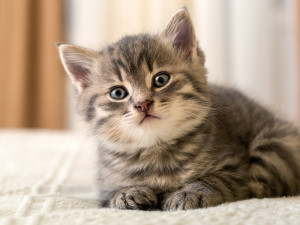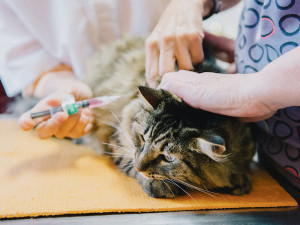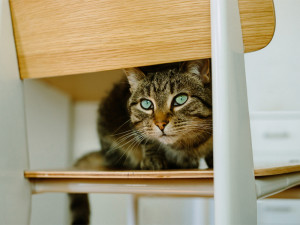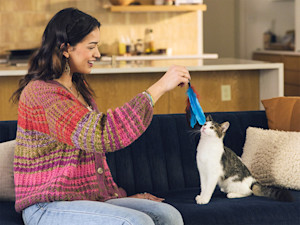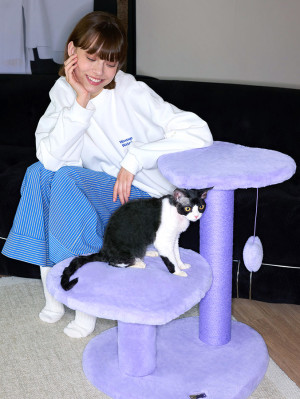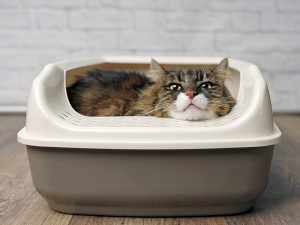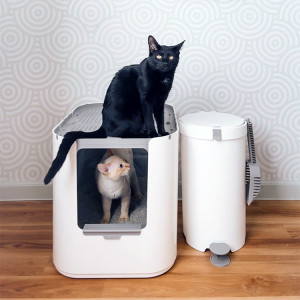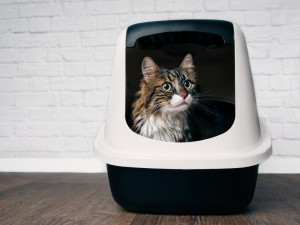Everything You Need to Get Before Bringing Home a New Cat
Set your new bestie up for success.
Did you hear the news? Kitten season, that assumed springtime period when shelters, rescues, and veterinary clinics see an influx in litters, now lasts all year. Because U.S. shelters are filling up, any time of year is a good time to bring home a new addition to your family in the form of a cat.
Once you’ve made the big decisions and found the bewhiskered pal that gets to be your companion for the foreseeable future, there are still about a thousand tiny questions left to answer. Where will the litter box go? Do indoor cats need collars? Catnip or silver vine? Cat backpacks: Cute, sure, but are they good for the cat?
“It takes a special kind of cat to enjoy a cat backpack,” says Marci Koski, Vancouver, Washington-based cat behaviorist.
So that’s one question answered, but how about the rest? Koski, who is also the founder of Feline Cat Solutionsopens in new tab and treats clients around the world, was on hand to help take the guesswork out of your pre-cat parent shopping list. As was Jennifer Van de Kieft, a Brooklyn-based feline behavior and feeding coachopens in new tab, and Samantha Bell, Los Angeles-based Best Friends Animal Society’s resident cat expertopens in new tab. Together, they built a comprehensive list of everything you need to have in the home before you bring a cat into your space, from the bare necessities (those items that will keep your cat alive and healthy) to the nice-to-haves (the stuff that could make pet parenting easier and enrich your kitty’s life, but won’t be sorely miss).
How much do you spend on your pet per year?
Parenting a small creature who is suddenly in your home can be overwhelming at the beginning, but all allow the list below to take a lot of the guesswork out of the process.
Must haves: You have to have these
The right kind of food
It may go without saying, but Van de Kieft is right when she says, “Nutrition plays a role in a cat’s happiness and health.” Cats are obligate carnivores, which means the majority of their food intake should be from meat. Generally, this means they require wet food, or at least dry food supplemented by wet food. Van de Kieft notes that if the shelter, rescue, foster, or breeder has had your cat on a low-protein kibble, i.e., one that is mostly corn and rice, then “the goal would be to transition them to a high-protein diet.”
There you go: Stock up on up on the protein.
Multiple food and water bowls
For both food and water, wide dishes work best for the comfort of the cat’s whiskers. Likewise, make the bowls glass or ceramics, not plastic. “Plastic can give cats chin-acne because it holds grease and oil in it,” Bell says.
You’ll also want to have multiple bowls for both food and water, but at least for water. “Studies show that cats like to drink water from multiple different sources. You don’t need a fancy fountain, but I would keep water away from the food dish and offer it in a couple different places,” Van de Kieft says.
Koski agrees. Put water bowls around the house. “Cats have pretty sensitive kidneys and you just want to make sure they're getting enough moisture,” she says.
Van de Kieft adds that cats should be fed many small meals: “The more meals the better, but at a minimum three meals.”
Litter box, litter, and litter scoop
Koski’s rule of thumb for litter boxes is that you need one more litter box than the cat you have. So, if you have just one cat, then you need two litter boxes, and if you have two cats, you need three litter boxes and so on. Van de Kieft adds that the boxes should be at least 50 percent longer than your cat. They should really be able to stretch out, find a spot they like.
“Just imagine for yourself, if you had the choice of an airplane bathroom or a nice, big luxurious bathroom, which would you choose?” Van de Kieft says.
As for litter, the best tends to be clumping litter. “Whatever litter they [the rescue or shelter] were using, you probably want to start off with that too so it’s not a shock. Maybe it’s a litter that's not a great litter, maybe it's scented, maybe it's really unnatural and you want to use a natural litter. You can transition to a new litter, too,” Van de Kieft adds.
Cat carrier
Carriers are a must, even for indoor cats. First of all, it’s what you’ll bring the cat home in, and it’s what you’ll take them to the vet in or what you’ll use to save them in an emergency. It’s just a good idea to keep a carrier on hand. (As a bonus, you can leave them out all the time as a safe hiding space for your little pal. This is especially good to do so that they’re comfortable with it when the day comes to to cart them off to the vet.)
Resting locations, especially ones that are high up
A cat bed on top of a bookshelf, a spot by the window on top of the couch. Cats love vertical spaces where they can survey their territory from the safety of all the way up there, so creating comfortable stations for them to hop up and relax is a must (more on this later).
And mix it up. “Cats have preferences so you want to make sure you're getting something that your cat likes. And cats like to rest in different places, too,” Koski says.
Scratching post
Koski puts it succinctly: “They’re gonna scratch. They need to scratch.”
Scratching is important for nail health, stretching, and for marking their territory. And if you don’t want them to scratch the furniture, then invest in good scratchers. “One scratching post is probably not enough,” Van de Kieft adds. “You need scratching posts throughout [your home].”
It may take some time and investment to discover what they like. There are posts made of seisil rope, others made of corrugated cardboard. They may need a taller, sturdier post to get the right angle and not knock the thing over. Expect a little trial-and-error here.
Wand toy
It’s debatable whether cats work hard, but they definitely play hard. They must play. A wand tool with a detachment that mimics the prey your cat likes, whether it’s a toy mouse or feather, will come in handy over and over again, helping to strengthen your bond with your cat, exercise them, and engage them.
As a bonus, per Van de Keift, “The more you play with your cat the less likely they are to exhibit behavioral issues. The wand toy is one of the best ways to mimic hunting. You can really get them to move around.”
Other toys
Do they like balls? Do they like mice? Do they like little curlicue things made out of pipe cleaner? Whatever it is, having abundant toys that your cat can play with on their own or with you is a really good idea. Just make sure you’re supervising them no matter what.
It doesn’t have to be complicated stuff, either. As Koski notes, “There are more gadgety cat toys out there and they are coming out all the time. I've tried some gadgety and gimmicky things, and my cats are like what the hell is that. Give me the wand toy, give me the milk cap.”
A vet appointment
A no brainer! “You should take your newly adopted cat to the vet within a couple of weeks of adoption for a full physical exam,” Bell says, “not only to ensure their health but also to establish a health baseline for better monitoring.”
Microchip
Both Van de Kieft and Koski agree that indoor cats don’t necessarily need collars (in fact it can be dangerous because they tend to jump around so much). Bell notes, however, that many companies make breakaway pet collars and could be a good extra form of support should anything happen.
Regardless, collar or no collar, make sure your cat is microchipped, so there’s a higher likelihood you will find them if they get out. “Have the shelter or rescue scan the cat to ensure their microchip is still in, and make sure the microchip records are up to date with your contact information,” Bell says. If they aren’t ‘chipped, the vet can get you one.
Highly, highly recommended: You’re probably going to want to have these
Hiding spaces, like tunnels
These are almost a must-have for all, and Bell did categorize it that way. “Cats instinctively want to hide, especially in new environments,” she says. “If we provide them with a cozy igloo, hide-y bed, or box right away they won’t get into the habit of hiding under furniture.”
These spaces can come in many forms. You can put a bed in a closet and leave the door cracked or keep the large cardboard box in which your latest delivery came, but you can also get a cat tunnel.
Tunnels are especially great, Van de Kieft says, because they double as devices for play. “At any given time I probably have like four or five tunnels out in my apartment, including one on my bed,” she says. “[Cats are] ambush predators, so sometimes they’re inside the tunnel and they'll pop out of the tunnels at their prey.”
Koski also has The Feline Fortressopens in new tab, which is, in short, a castle for cats. “They make all sorts of configurations,” she says. “There are scratchers in there. They drag their cat toys in there. I put treats in there occasionally.”
It makes a lot of sense to go in for the cat castle considering these small, innocent creatures are going to be your new sovereign, whether you realize it or not.
Cat tree
This is one of the best ways to give your cat the vertical height they crave. Cat trees are also generally multipurpose, Koski points out. “They have places where the cat can get up high, they have little places where the cat can be enclosed in something, and they also have places where they can scratch on them too,” she says. It’s a win-win-win.
Water fountains
Having various bowls to drink out of is still important, and, in addition, Koski recommends a fountain.
“They run all the time, and that sound of running water can attract them and help them drink more water,” she says. “And some cats just like them better than a stagnant bowl of water.
Food puzzles
A great enrichment tool that can also aid a busy feeding schedule. “Working for food is an important part of mental stimulation,” Van de Kieft says. “You can also mix it up, especially if your cat is indoor only, using a food puzzleopens in new tab for one feeding, doing a scavenger hunt for the next. [It’s] one way to help with that mental stimulation and keep things fun.”
Feliway diffuser
This one is especially good to have for the transition to a new space, whether you are bringing a cat home for the first time or moving. “The Feliway Classic Pheromones are synthetic versions of the marking pheromones that cats use to claim their own space. So it helps them feel a little more familiar with their surroundings and can help calm themopens in new tab,” Koski says.
An enzymatic cleaner
You know why, and if you don’t, you’ll find out soon enough.
Nice-to-have: You made it this far. Might as well go all in, right?
Cat shelves
Not necessary if you already have a bed on top of a bookshelf or a cat tree, but if you’d like to offer your cat another high-up option, this is a good one. And have you checked in with cat-shelf wall technology opens in new tab recently? There’s a lot to love out there.
Catio
A patio for your cat, of course! This is for indoor cats who wants to enjoy the great outdoors, and it’s sights and sonds. There are larger catio for larger spaces, and also simple window boxes for the apartment. “Any time of year, all types of weather, if they want to go, they can go out. It's great enrichment,” Koski says.
I invite you to lose a day exploring all the catio options out there.
Heated cat mat
You’ve heard of falling asleep in a sunbeam, but have you heard of heated cat matsopens in new tab? They’ll warm up your pal.
“Cats have a much higher thermoneutral zone than humans do so when we’re comfortable they can be a little chilly so giving them some heated spaces is really convenient,” Koski says.
Put that heated space high up, and you’ve got a cat oasis. A catasis? A coasis? You get it.
Cat cam
To check in on them when you’re away. There are many options out there.
Grooming tool
Depending on the length of you cat’s coat, you’ll need to keep an eye on their grooming needs. Here are some tools that might be helpful to add to your cart.
Electronic toys
Sit back and let robots take the wheel (at least as a supplement to all the good play you do with your energetic cat already).
“If you work from home and you're not that busy and you can play with your cat all day, by all means stick with the wand toy. But for a lot of people that's unrealistic. Some cats really do have a lot of energy,” Van de Kieft says.
Odor enrichment
Van de Kieft notes that, especially if cats are indoor cats, it’s a good idea to give them a lot of things to smell throughout the day. It helps alleviate boredom and engage them. There are a lot of options for this. CatNip. Valerian root. Silver vine. Honeysuckle. Just reaching down and letting them smell the herbs you’re cooking with, like parsley. If you don’t have time to forage through the fields or even the grocery store, MeowyJane.comopens in new tab sells an herb enrichment pack, special for cats.
A trainer
Hiring a trainer is something to think about even before behavioral issues arise (though if these issues do arise, training moves up to the “must-haves” list).
As Van de Kieft puts it, “We don't think anything about teaching a dog to sit, but it's like we would never do that with a cat. Meanwhile, they’re animals. They learn all the time. You can teach them tricks and cues. Especially for cats that need more, it can be great mental stimulation.”
It’s bonding, it’s enrichment, it’s play. It’s having a little language with your friend.
Still more toys
Van de Kieft recommends a kicker toy for kittens while they’re still doing an impossibly cute thing called “bunny kicking.” They grab your arm with their arms and kick you with their feet. A kicker toy will replace your arm, so you can get back to doing whatever you need your arms to do.
There’s also the ripple rug, a “genius product” that’s great for active cats. Van de Kieft recommends more toys for enrichmentopens in new tab on her own website — all tested and approved by her five cats at home. Nina Ottosan also makes great onesopens in new tab.
As Koski reminds us, kittens will simply need more. “Kittens are like little monkeys, so you just need more of everything,” she says. “More toys, more things to climb, more things to scratch.”



